Wonderbird Spirits Distills the Flavors of Mississippi
The Taylor distillery taps local Delta rice and botanicals for their standout gins, served in cocktails throughout the South
Welcome to the weekend! Here’s what you’ll find in this week’s newsletter:
Cover Story: The gins created at Wonderbird Spirits in Mississippi speak to the flavors of the state. This week, we trace their gin’s path from the farmers in the rice fields of the Delta to the distillers crafting the spirits in Taylor to the bartenders serving cocktails in New Orleans.
The Order: Head to the coast of Connecticut to try one of our favorite buttery lobster rolls.
August’s Featured Field Guide: Our Field Guide to Boston is included in a paid newsletter subscription this month! This 48-page dining guide includes a curated four-day itinerary with 30+ recommendations for breakfast, lunch, dinner, and drinks.
Weekend Reading: Midwest escapes, San Diego hotspots, Cape Cod getaways, St. Louis breweries, and more!
Mississippi In A Bottle: How Wonderbird Gins are Infused with the Spirit of the State
TAYLOR, MISS. — If you visit Mississippi during the late spring or early summer, you’ll catch a whiff of magnolia blossoms. The large white flowers bloom on Mississippi’s state tree and have a sweet, heady scent; it’s an aroma that places you squarely in the South. I’ve smelled magnolia flowers in Texas and Louisiana, Tennessee and South Carolina. But only in Mississippi have I had them to drink.
No. 97 Magnolia Experimental Gin, made with fresh flower petals, is one of four gins from Wonderbird Spirits, a distillery in Taylor, about 10 minutes outside of Oxford. A tight-knit college town, Oxford is home to the SEC’s Ole Miss and beloved local institutions like Square Books. It’s also home to a thriving food scene. City Grocery and John Currence’s subsequent restaurants put the town on the culinary map, but there is so much more in this little pocket of Mississippi, from Joe Stinchcomb and Ross Hester’s Bar Muse, a sliver of a cocktail bar in the Lyric theater, to Ajax Diner, where a single meat-and-three plate could feed you for days. Driving down the road to Taylor (not far from the great catfish and live music joint Taylor Grocery) you’ll find Wonderbird Spirits, a distillery set on a 20-acre plot of land on Old Taylor Road that had long been a fallow field. There, founders Thomas Alexander, Rob Forster, and Chand Harlow make gins that speak to Mississippi’s sense of place, through the botanicals they use and through the local jasmine rice that forms the base for their gin.
New American distilleries today often include a wide range of spirits in their portfolio, from white whiskies and aged bourbons to domestic rums and specialty vodkas. Wonderbird, which was founded in 2018 with the first bottle arriving in May 2019, is rare. The founders’ sole focus and passion is gin.
“We love martinis, we love a beautiful Negroni,” Forster says. “We esteem gin’s place in cocktail culture and cocktail history. We love its versatility; it can go in a million different directions.”
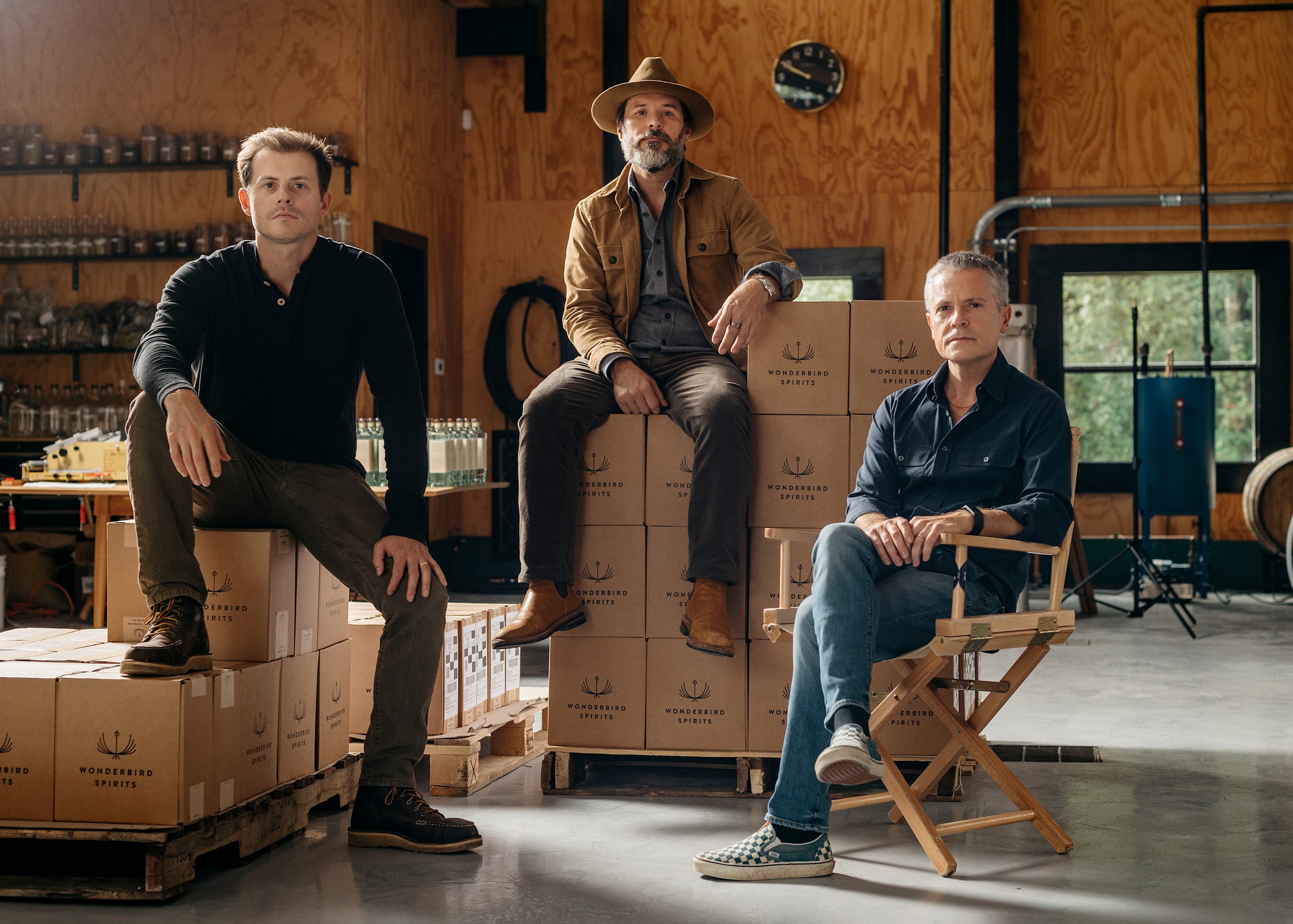
At Wonderbird, gin goes in four directions. Besides the No. 97 Magnolia Experimental Gin, there’s Gin No. 61, the flagship offering with 10 botanicals, including pine needles and red clover from the distillery grounds; Cask Finished Gin, which is the No. 61 finished in a bourbon cask for 75 days to add caramel and vanilla notes; and the brand-new Dry Gin, done in the style of a classic London Dry. The same distilled rice base is used for all, then the botanicals or aging process set each particular gin apart.
But in the spirits world, it’s the rice that sets these gins apart. Wonderbird is the only producer of rice-based gin in the U.S. There are some Japanese rice-based gins, like Ki No Bi, but it’s a small field. “We didn’t start off saying, let’s make this out of rice,” Forster says. “We’re three guys who left corporate careers and knew we were going to get one shot at this. We were like, ‘let’s make this as excellent as we possibly can and satisfy our own par of excellence.’ If we do that, maybe we’ll succeed but at least we’ll make ourselves proud.” It’s that ethos that led them to rice.
Agricultural Influences
Mississippi is an agricultural state, so the folks at Wonderbird began by trying different locally grown ingredients. “We tried many different types of corn and spent a moment screwing around on sweet potatoes, which are grown in prolific quantities in Panola County, the next county over from us,” Forster says. But an introduction to Mike Wagner of Two Brooks Farm in Sumner about an hour away in the Delta led them to jasmine rice. “Mike drove up and dropped off four varieties of his rice and said, ‘Mess around with them and see what happens,’” Forster says. “Mike’s jasmine rice put off this distillate that was so clean and had such great clarity. It had the natural aromatics from the jasmine and was putting off this creamy, silky mouthfeel. The question answered itself.”
At Two Brooks Farm, Wagner grows multiple kinds of rice, including black, red, Missimati (a basmati-like rice), and sushi-grade (which you can try at Chez Philippe in the Peabody Hotel in Memphis, among other restaurants). But Wagner felt that jasmine would work best because of its low amylose content, which he says is great for distilling. Fly Llama Brewing, a brewery in Biloxi along the Mississippi Gulf Coast, also uses the jasmine rice to make lager. That rice is “aromatic and floral,” Wagner says. “Some might call it popcorn-y.”
Wagner comes from a long farming family and started Two Brooks 30 years ago. While he also grows soybeans, the Delta is a particularly good part of the country for rice. “It's flat so it's easily irrigated,” he says. “My place has very rich soil. We are in one of the greatest flyways in North America and waterfowl fertilizes the soil. It grows our jasmine quite well.”
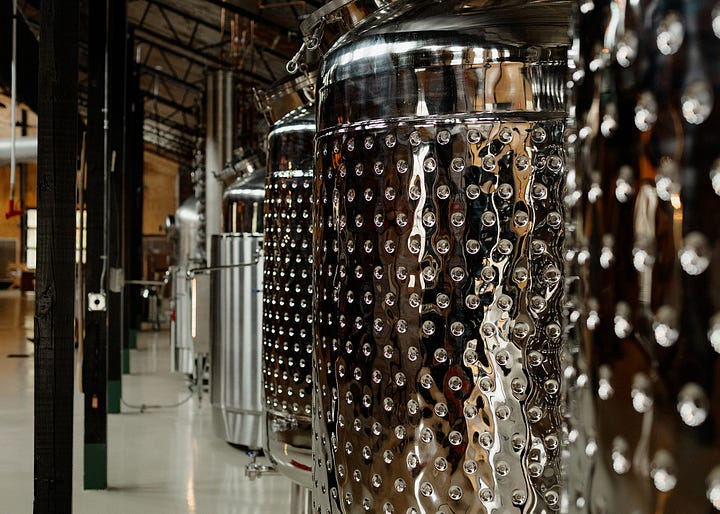
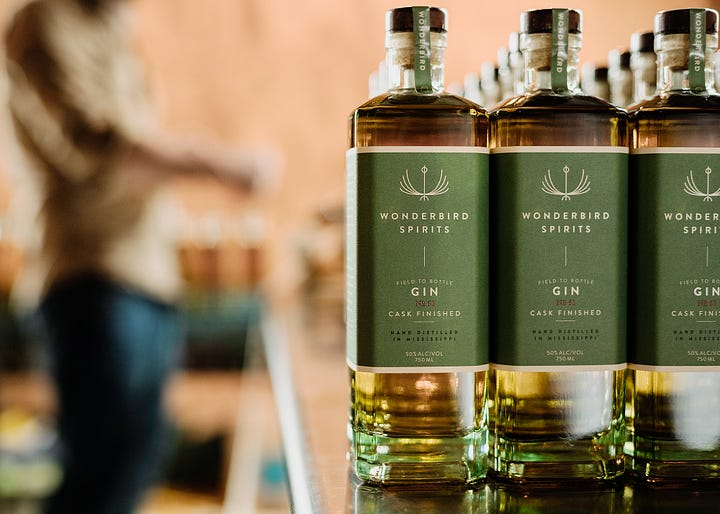
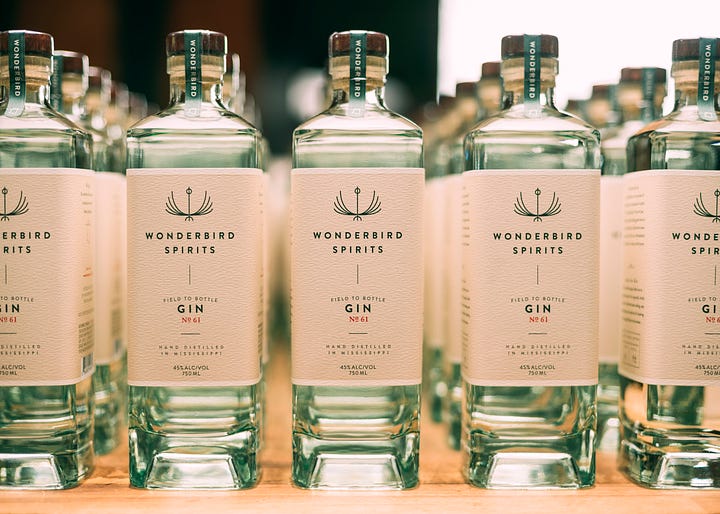
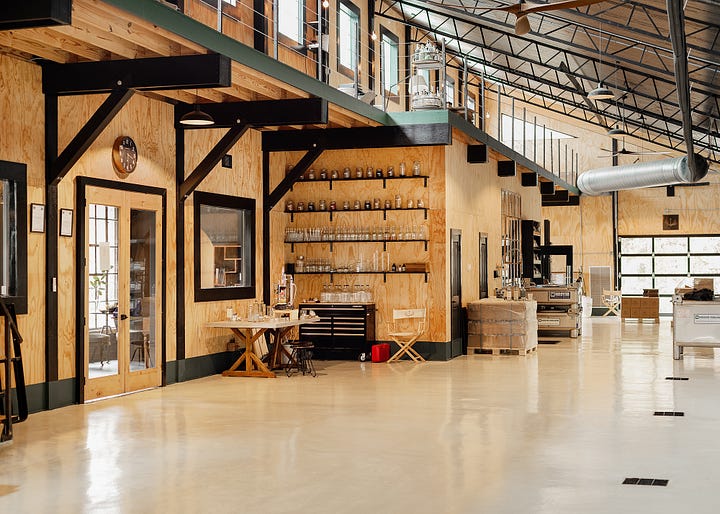
Getting that rice was the first step. None of the founders knew how to distill, but they knew they wanted to do it themselves rather than purchase a neutral grain spirit. “We had to learn how to ferment on rice and then learn how to make gin out of that base alcohol,” Forster says.
For the fermentation, they opted to use koji, a Japanese mold spore that breaks down the rice (Wonderbird’s friendly gray distillery cat is named Koji; “She was hired as an assassin but she has manifested as a lover,” Forster laughs.) “Nobody in the state really knew how to work with rice in this capacity, so it was a huge learning curve,” Forster says. “Tom and Chand really cracked the books to figure out how to do this stuff.” They wanted to produce faster than sake breweries — “a lot of breweries are fermenting for 40, 60, 80 days, and we didn’t want to wait that long just to yield a basic alcohol” – so they figured out how to speed up the process with heat. “It was a mad scientist era we went through,” Forster says.
To make the gin, they distill each botanical separately on their 150-gallon Alabama-made hybrid still, then blend them later. “If you talk to any distiller, they're going to say it makes perfect sense but it’s so much more labor intensive,” Forster says. The Magnolia gin is made with local flowers. “We’d go to people’s backyards and give them a bottle of gin and say, ‘Hey, can we take some flowers?’” Forster says. “They deliver that big, round buttery note that’s so beautiful.”
For their flagship gin, the “61” refers to the sixty-first combination they tried with the botanicals they use. That primary build includes 10 botanicals: Italian juniper, coriander, angelica root, fresh Meyer lemon peels, lemongrass, black tellicherry, bay leaf, and rosemary. They forage the distillery’s grounds for red clover tops and loblolly pine shoots “from a little pine tree in our back pasture.” Forster says: “This gin can only come from Wonderbird Spirits in Taylor, Mississippi.”
Grain to Glass
Wonderbird’s gins appear all over menus and back bars in Taylor and Oxford, such as Grit and Snackbar, where we tried their barrel-aged gin in a Martinez. But the footprint is growing around the South.
Their gins can be found in cocktails at bars and restaurants in Atlanta, including Georgia Boy, Whoopsie’s, and The Deer and the Dove, and at both The Fox Bar & Cocktail Club and Bay 6 in Nashville. Bay 6 is currently serving a gin fizz with rice shochu, genmaicha, orange, and cream.
One of the best cocktails I’ve had this year has been the Pearl River at Cure in New Orleans. Made with Magnolia gin, Hamilton white rum, Smokeshou tea syrup, blanc vermouth, and black lemon bitters, it’s a soft and nuanced martini served on ice. Cure bartender Gina Hoover, who is also a brand ambassador for Wonderbird, created the drink.
“I wanted to feature the Magnolia,” she says. “The flavor profile just really speaks to me. As I found out more of the story about it, it started to open up into a love letter to the region. It connects Mississippi to Louisiana. I learned that we share the state flower, the magnolia, with Mississippi.”
Hoover already loved the spirit before becoming a brand ambassador. “They don’t cut corners,” she says of the founders. “They don’t mince words. They’re storytellers creating something of world-class quality, and that’s a world that I wanted to be a part of.”
To her, one of the gin’s standout elements is its texture. “That's what I first latched onto,” she says. “Because it retains some of the rice quality in the distillate, you’re always going to have that lovely, silky body. It plays so well with others, especially rum. There are so many savory notes in rum that are not really utilized, and together they bring out different qualities than you’d normally see.” Hoover adds a syrup made with a smoked tea from Fujian for its “woodland flavor” that enhances the astringent qualities of the Magnolia.
Hoover also uses Wonderbird gin in a gimlet variation with bergamot, rose, and clairin, and says the gins work well in a martini, particularly one that’s frozen, as freezing amps us the gin’s silky qualities. She also recommends the Magnolia gin in a white Negroni (Forster does, too). Hoover says, “You have the florality coming from vermouth and it’s in the gin as well, so it’s kind of a layup.”
Neal Bodenheimer, the managing partner at Cure as well as several other bars in New Orleans, held an event this past spring at the distillery, where he was interviewed by chef John Currence of City Grocery about his book, Cure: New Orleans Drinks and How to Mix 'Em. It also gave him a chance to see the distillery.
“You can tell they care deeply about what they do and the space they do it in,” Bodenheimer says. “For me, the most important thing was to see how ingrained they are in the community and how excited people are in Oxford about what they do. I was talking to a guy there who said, ‘I never even drank gin before, then these guys opened and now I’m all into gin.’ That’s so wild. You see a thousand craft distilleries people don’t give a shit about but people really care about [Wonderbird], and they should because those guys are doing great things.”


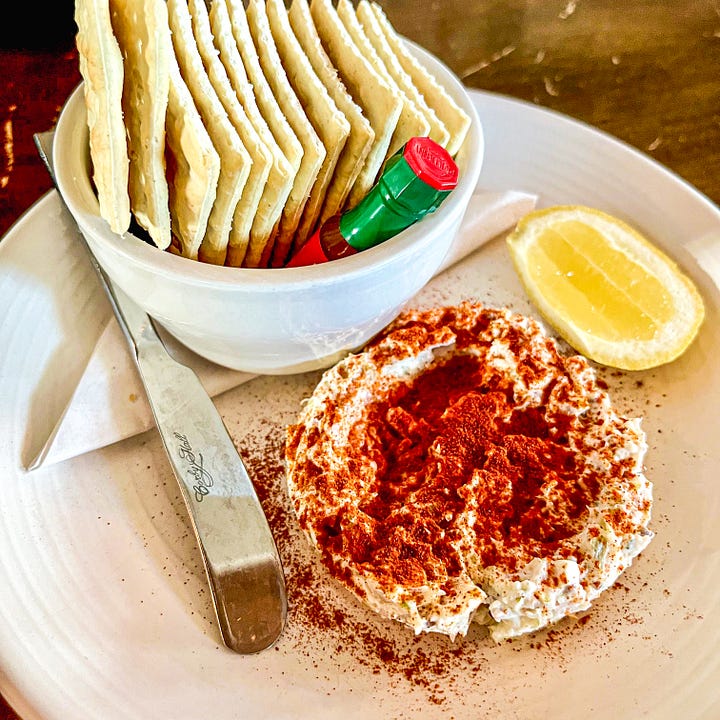
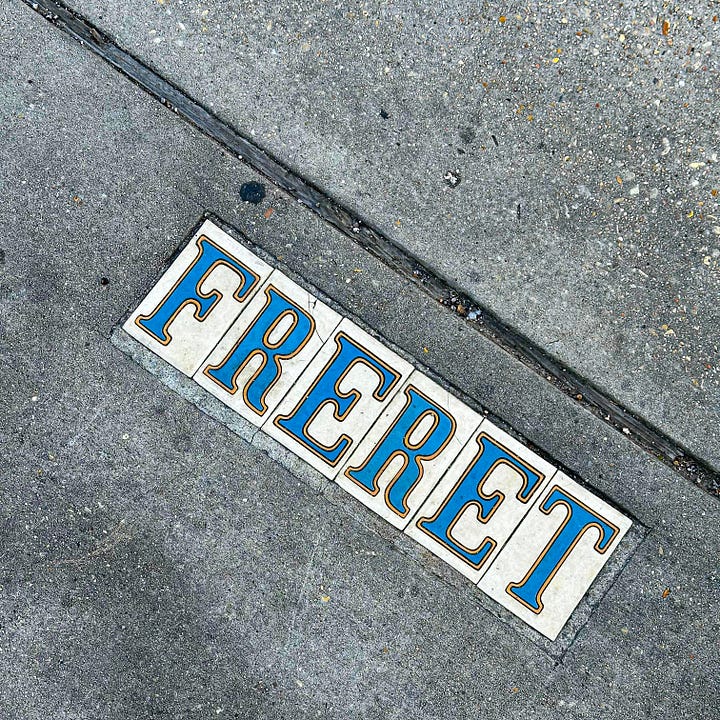
Bodenheimer admires the gins for their quality. “They’re such pretty products that we find ourselves using them in really delicate things.” He also admires them for what they mean to the South and to Mississippi. “I think it’s amazing that Wonderbird is in Oxford,” he says. “I think it’s their greatest strength and greatest weakness as they try to grow the brand. Oxford is such an amazing community with amazing people and a food and drink scene that punches well above its weight. So in some ways, it’s a perfect place for what they do. On the other hand, when you get out of the South, people are like, ‘Mississippi?’ Unless you know Oxford, it carries the Mississippi baggage with it.”
Forster acknowledges this, too. “We know we’re from a state that gets kicked around in national dialogue,” he says. “People don’t think of Mississippi as producing superb handmade products.”
But these gins are superb.
“I’ve heard multiple people I respect deeply in other markets say ‘Have you had Wonderbird? It’s incredible.’’” Bodenheimer says. “A lot of people think it’s one of the better domestic gins on the market. As people discover it, it’s going to become a cult product. I really think they’ve got something that is pretty singular.”
Wonderbird makes 1,000 to 1,500 bottles a month, so it is still a micro-distillery, but the team aims to change that quickly. “If we’re ever going to really be a financial success, we need to be able to make gin at a larger scale,” Forster says. “The goal is to take that number three, four, five times higher sometime this year if we can find the markets to do that.” The increased capacity is possible because of a recent renovation of the distillery. To add more capacity, they recreated the space elsewhere on the land, tripling the building size and bringing in new custom equipment, including three fermenters. “We added 10 times the capacity,” Forster says. “We’re not humming at that capacity right now, but the idea is to produce at a much greater volume when the time is right. Now the challenge for us is to build all those markets that will justify that huge expense.”
You can visit the distillery to pick up a bottle of gin or merchandise. (Both are available on their website as well.) And you can also make a reservation for Thursday night cocktails. “We believe that once people see what we’ve created and have our gin on site, we’ll earn fans that way,” Forster says. “It’s 10 people tops, it’s intimate and personal. We’re trying to have an experience with people for 45 minutes.” There, you can try the gins in a martini or gin and tonic or a daily special. “We have a conversation about how we came to do this, why we do this,” Forster says. “Then we give people a drink and walk them through the production facility. It’s generated a lot of positive momentum for us because 45 minutes later people feel like they know why this is special. And then they go out into the world and the next time they’re having a drink they’re going to say, ‘I went to this cool place in Taylor, Mississippi.’”
618 Co Rd 303, Taylor, MS 38673 | @wonderbirdspirits
Lobster Roll at Lobster Landing
CLINTON, CONN. — While in recent years, I’ve spent considerably more time in Maine eating their style of lobster rolls (cold with mayo), I cut my teeth on the Connecticut style (warm with butter). Growing up, our annual summer visit to Abbott's Lobster In the Rough was always a special treat, since I loved the lobster and crab rolls, which come served on a hamburger bun, plus the relish-y tuna salad, which was a very underrated item. While I think Abbott’s is still great, over recent trips to the shore, I’ve changed my preferred Connecticut roll to Lobster Landing. located about 45 minutes to the west.
Lobster Landing is located in Clinton at a quaint marina. There’s a picturesque white shack with a red lobster affixed to the front (the shack is over 100 years old; Italian immigrant Enea Bacci opened the restaurant in 1995), crushed shell pathways, and boats sailing along. It’s just the right ambiance for a lobster roll. Bacci’s version has a generous amount of tender meat that’s tossed with butter and a little lemon and tucked into a grilled sub roll. It’s my ideal take on the Connecticut style.
152 Commerce St, Clinton, CT 06413 | @lobsterlanding
All Month: Download Our Four-Day Dining Itinerary in our Field Guide to Boston!
Want to plan a trip to Boston? Our full list of favorites is available in our Field Guide to Boston — free this month for paid newsletter subscribers. This 49-page dining guide includes a curated four-day itinerary with 30+ recommendations for breakfast, lunch, dinner, and drinks. It’s downloadable for offline reading, includes Google Maps and Instagram links, and is formatted for your phone — perfect for easy reference on your next trip. Paid subscribers to American Weekender can download this Field Guide for free using the discount code in this month’s Weekend Getaway issue. They also receive 50% off any additional guides.
Sweet Escapes
Just before the Democratic National Convention hit Chicago, Amy talked with the City Cast Chicago podcast to share some favorite weekend escapes for folks hoping to get as far away from the political madness as possible. Amy talks about some of our favorite Midwest destinations including Milwaukee, Nashville, Louisville, Cleveland, and more.
CALIFORNIA
Two Great Spots in San Diego: “Not every place I ate across San Diego made it onto my new guide of nearly two dozen standouts. Ichifuji and Mal Al Sham most certainly did,” writes Bill Addison for the Los Angeles Times.
MASSACHUSETTS
An Insider’s Guide to Cape Cod: Writer Kate Whouley shares how to enjoy the Cape like a local for Yankee Magazine.
MICHIGAN
Michigan Central Station Is Restored to Its Original Glory: Architectural Digest has photos of the beautifully restored train terminal, where more than 3,000 artisans helped revive Detroit’s 1913 Beaux Arts landmark, writes Sam Cochran in Architectural Digest.
MISSOURI
A guide to St. Louis' brewery scene: St. Louis has a robust beer scene and Jordan Palmer of St. Louis Magazine shares how to tackle it on your next trip.
— Compiled by Kenney Marlatt
Want more? Chat with us on Substack, download our Field Guides, check out our archives, or follow us on Instagram @americanweekender. We’ll be back next week.





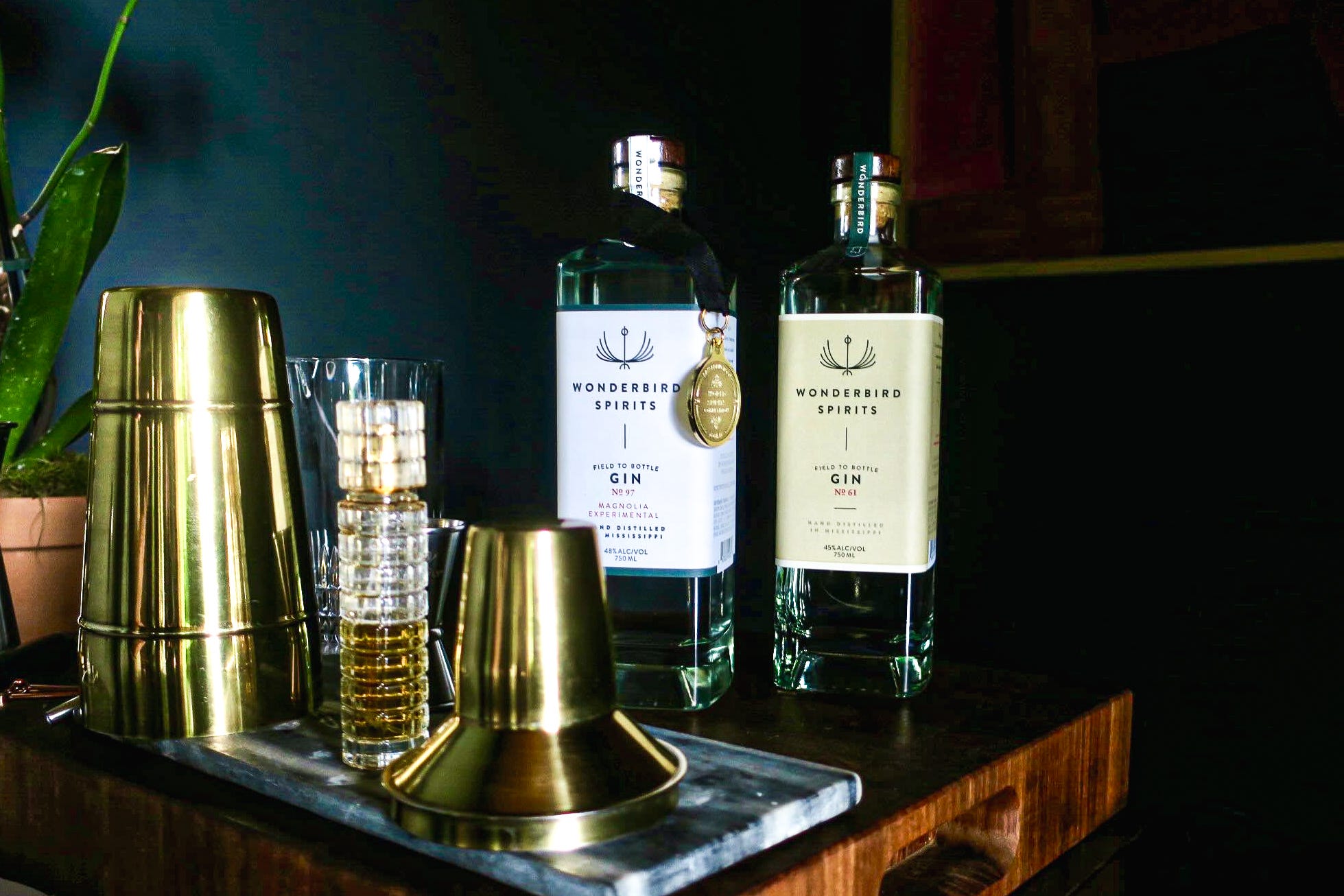

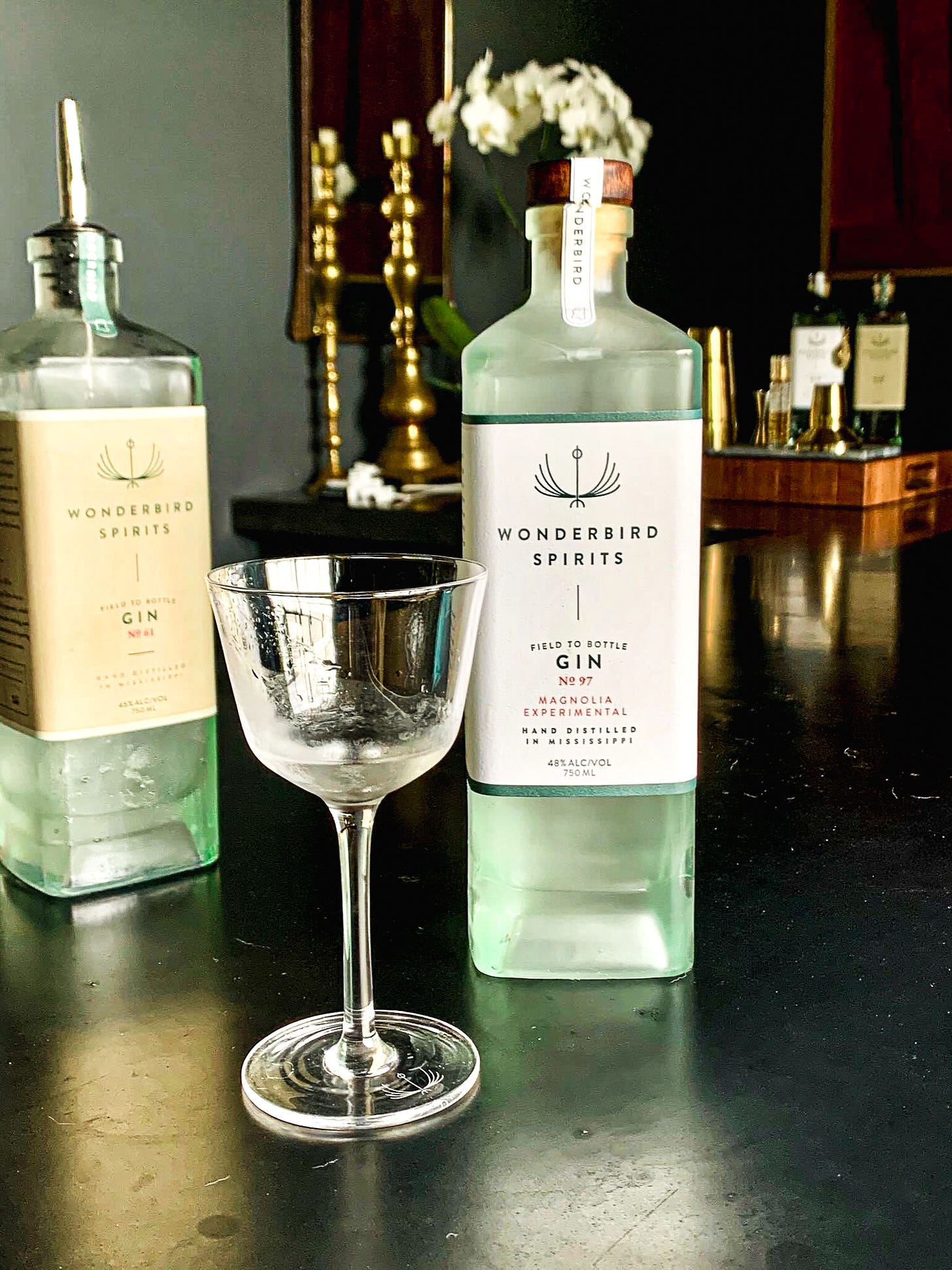










Koji! 🐈
Great write-up. I’m a big fan of Wonderbird. Would it be ok if I shared your great pic of sweet Koji on Distillery Cats (with credit, of course)?